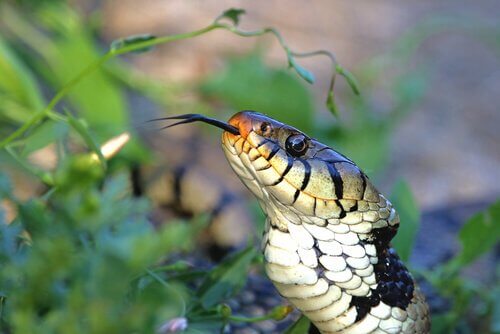The Vomeronasal Organ in Snakes

As well as using their nostrils, many vertebrates can gather information from the air using the vomeronasal organ. In snakes, this ability is highly developed. In this article, we’ll tell you all about the vomeronasal organ in snakes.
The vomeronasal organ: a sensory organ that detects substances in the air
While this organ is mainly used for detecting pheromones, snakes can use it to sense lots of different chemicals. They can use it to find prey and even to recognize members of their own family.
So how does it work? Using their forked tongue, snakes “collect” chemicals from the air. This information goes to the palate, and then on to the brain via the vomeronasal or Jacobson’s organ. It is located behind the vomer bone, between the nostrils and the mouth.
As well as the ability to “decipher” this information, many serpents can also use this organ to detect the body heat of warm-blooded animals.

Learn more about the vomeronasal organ in serpents, which allows them to gather information from their environment.
Some interesting facts about the Jacobson’s organ
The Jacobson’s organ was first discovered in 1811 by Danish surgeon and anatomist Ludwig Lewin Jacobson, which is how it gets its name. It forms part of the olfactory system in mammals, reptiles and amphibians.
This organ is particularly useful for the transmission of chemical signals between related members of the same species, in particular when it comes to breeding.
Scientists believe that they also use it to detect territorial signals, which is a huge issue in the animal kingdom.
But as you might have guessed, in snakes the vomeronasal organ is vital for tracking and hunting prey. It forms during embryonic development and is part of the nasal cavity, creating an opening at the top of the mouth.

Snakes’ tongues are perfect for sending information to the Jacobson’s organ. They have hundreds of small papillae which capture different scent particles. As a result, you might say that reptiles smell the air with their tongues.
Their forked tongue allows them to locate the source of the chemicals more efficiently. After passing through the vomeronasal organ, the information obtained by each fork takes a separate path to reach the brain.
The vomeronasal organ in other animals
To give you a better idea of how the Jacobson’s organ works, let’s take a look at another example: cats.
You may have even witnessed it in action without realizing exactly what it was you were seeing. If you haven’t, pay close attention, and you might just spot it.
Sometimes, your cat will half-open its mouth and breathe deeply. At the same time, it will curl its lips, wrinkle its nose, and raise its head slightly.
This mechanism is known as the Flehmen response. It allows cats to transfer the air and the information it contains to the vomeronasal organ.
And in case you were wondering, humans also have a Jacobson’s organ. However, scientists can’t seem to agree on what role it actually plays in the human body…